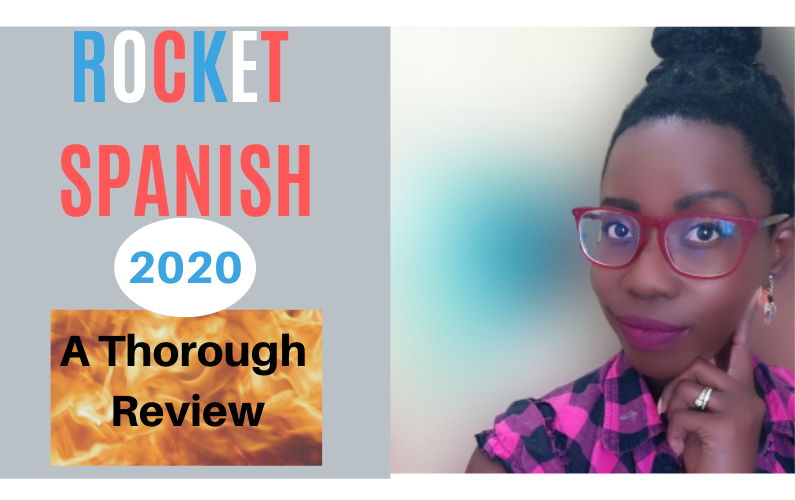So after taking a thorough look at Rocket Spanish, it kind of left me wondering why it’s not the most popular Spanish-learning program on the market.
If you would prefer to watch this review in video format, please see the video here. Otherwise, keep reading!
I’m all about bringing you both the tips and the tools that, when combined, will help you to achieve a fluent level of Spanish, like I have been able to achieve. Above all, I want you to be able to learn Spanish in a flexible way that keeps you motivated and fits into your busy schedule. That’s why I’m super pumped to do this Rocket Spanish review!
So I actually purchased all three levels of Rocket Spanish with my own money just so that I could give you guys the most thorough review possible. But I am now a proud affiliate of Rocket Languages, meaning that if you do make a purchase I may receive a commission at no additional cost to you. You’ll be seeing why I strongly believe in this product so trust you’re in good hands.
Why Am I Reviewing Rocket Spanish?
In case you’re new around here and don’t know me, I’ll give you a recap on myself in order to explain why in the world I’m reviewing this product.
Well, I’m a girl from Kentucky. I grew up in a monolingual household. English was all that I knew, all that my family knew, and all that I thought I would ever know. But all that changed when my family and I became involved in a volunteer teaching work in our local Spanish-speaking community. To accomplish it, we had to find some way to actually learn Spanish (duh).
So fast forward a couple of years later and I had gone from zero Spanish to sharing actively in this Spanish-speaking community work.
But there was more. At this point, I had also become a professional certified Spanish/English medical interpreter and translator, and was often mistaken for a native Spanish speaker by native speakers.
People asked me all the time, “How did you learn Spanish so fluently?” I mean I didn’t study Spanish in college. I didn’t move abroad until years later.
Eventually, after seeing so many people struggle with language classes that were failing them and seeing friends who, after 4 years of university Spanish, could barely hold down a conversation, I finally sat down and found a way to bottle up everything that I learned about language learning. I created what I call my 6-method system, one of those methods being beginning with a flexible, online, language course.
Finding a good Spanish course to recommend was not easy. There are a lot of options out there. Some approach language learning very differently than what I recommend by taking random vocabulary and phrases and sentences and basically expecting you to just memorize these through repetition.
Other courses, while moderately effective, are kind of boring and hard to stick with. Others put so much emphasis on grammar that you end up being an expert on the past participle of verbs, but you wonder at what point you’re actually going to start speaking and understanding the language. I just couldn’t get behind some of these programs.
Eventually, I found Rocket Spanish and tried it out. I was pleasantly surprised and you’ll see why.
Who is Rocket Spanish for? Who is it Not For?
Rocket Spanish takes you from absolute beginner to an advanced conversational level. So it’s great for all beginners and intermediate students.
If you are more advanced and comfortable with most conversations, I would not recommend Rocket Spanish because it may be too basic for you. Instead, I would suggest focusing on improving your vocabulary and fluency through more advanced Spanish stories, podcasts, and of course, as much real-life conversation as you can get.
Rocket Spanish is great for busy people who need the motivation to get language learning in their day. The lessons are digestible, can be downloaded to use offline, and are mobile-friendly.
The Rocket Spanish Interactive Audio Lessons
There are three levels. Each level has different tools that you’re going to use. The meat and potatoes of Rocket Spanish are the interactive audio lessons. There are a total of 22 modules and 98 interactive audio lessons throughout all three levels. You can see them in the screenshots below.
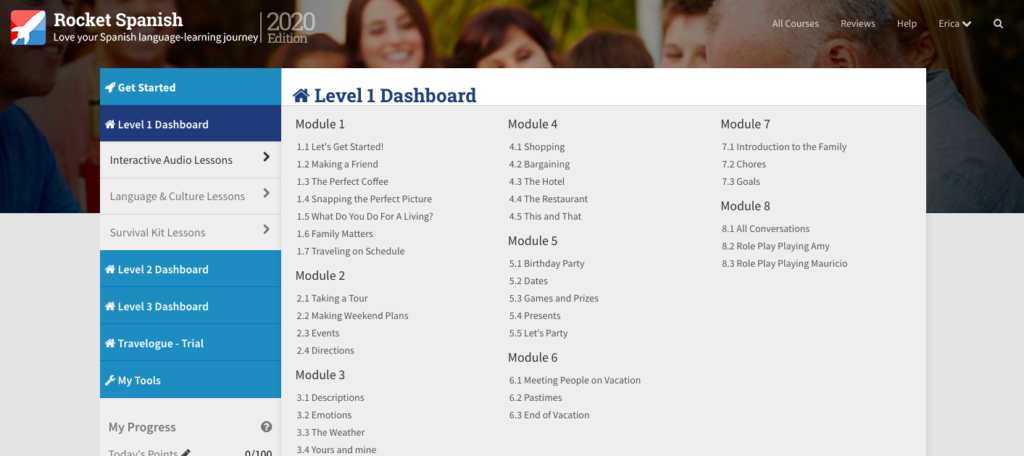

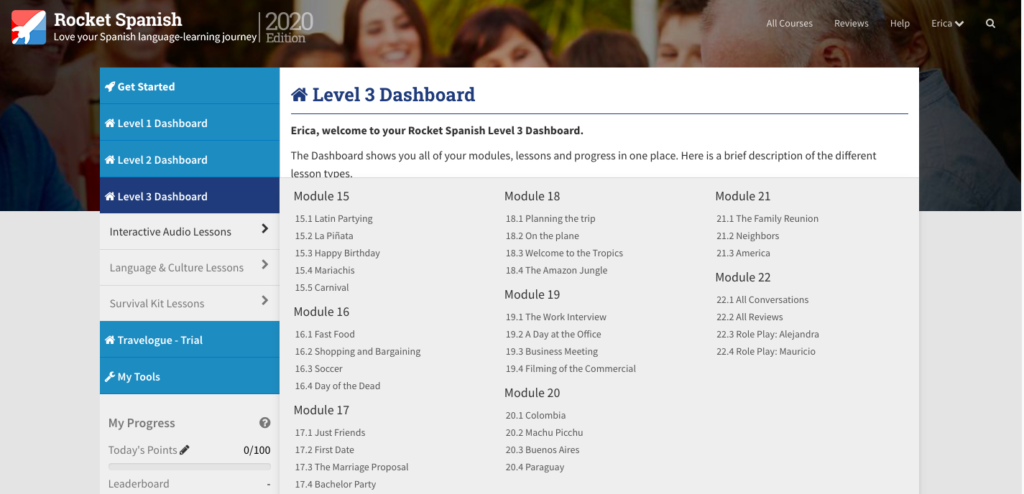
Let me show you how these lessons work. We’ll choose Level 1, Module 1.7, Traveling on Schedule. This audio lesson is 22 minutes long. The audio lessons vary from around 20 to 30 minutes each. So you really get a good amount of audio lesson. That time usually includes a review, overview of what’s coming up, the Spanish conversation, explanations in English, and interactive exercises. The lessons are fun, engaging, and follow real-life circumstances.
Throughout the entire Rocket Spanish course, we’re following along the characters of Mauricio and Amy. Oftentimes other characters come on the scene as well, which is great because we get to hear different accents.
Let’s see a little bit of Module 1.7. If you want to hear this in the video, this starts at timestamp 4:32.
[BEGIN AUDIO CLIP]
Amy: [04:32] Welcome to lesson 1.7 of the Rocket Spanish interactive audio course. These lessons teach you to speak Spanish through leading you through the pronunciation of the most common words and phrases. In this lesson, you’re going to learn how to talk about the time. The situation in which time matters most is when you have to get somewhere for something. And in this case, Mauricio and I have to get to the airport for a flight to New York.
Mauricio: [04:57] ¿A qué hora es el vuelo?
Amy: A las siete y media de la mañana.
Mauricio: ¿Qué día?
Amy: El diez de agosto.
Mauricio: ¿Cuándo llegamos a Nueva York?
Amy: Llegamos a las diez de la noche el mismo día.
Mauricio: Ah, tenemos que salir temprano.
Amy: Sí, ¿cuándo sale el tren al aeropuerto?
Mauricio: El tren al aeropuerto sale a las cinco de la mañana en punto.
Amy: ¿Cuándo llega?
Mauricio: Cuarto para las siete.
Amy: Es muy tarde.
Mauricio: ¿Por qué?
Amy: Porque tenemos que llegar al aeropuerto de las seis.
Mauricio: ¿Qué haremos?
Amy: Vamos en taxi.
Amy: [05:33] Did you understand any of that conversation? In this lesson I’m just going to review some common time-related questions rather than explaining how to tell the time. Are you ready? Here are the first two lines of the conversation again. Do you have any idea of what’s being said?
Mauricio: ¿A qué hora es el vuelo?
Amy: A las siete y media de la mañana.
Amy: The question “¿A qué hora es? means “At what time is?”. You could ask, “¿A qué hora es el desayuno?”, at what time is breakfast? “¿A qué hora es el tour?”, at what time is the tour? “¿a que hora es la reunion?”, at what time is the meeting?
The question “¿a qué hora es?” is extremely useful, so let’s break it down word by word with Mauricio.
Mauricio: ¿A qué?
Speaker: This means “At what?” Practice your pronunciation.
Mauricio: “¿A qué?”
[END OF AUDIO CLIP]
So that gives you an idea of how it works. Anytime we’re practicing pronunciation, we’re practicing with Mauricio, who is a native Chilean speaker. You can hear that the narrator is a gringa, as you can tell from her accent, but fortunately, when it comes down to practicing the pronunciation, we’re doing it with Mauricio.
Rocket Spanish “Play-It” Role-Playing Activity
Now let me show you some of the other features in addition to the audio lessons. There is a lot more!
So “Play It” is my absolute favorite feature of Rocket Spanish. We’re going to role-play.
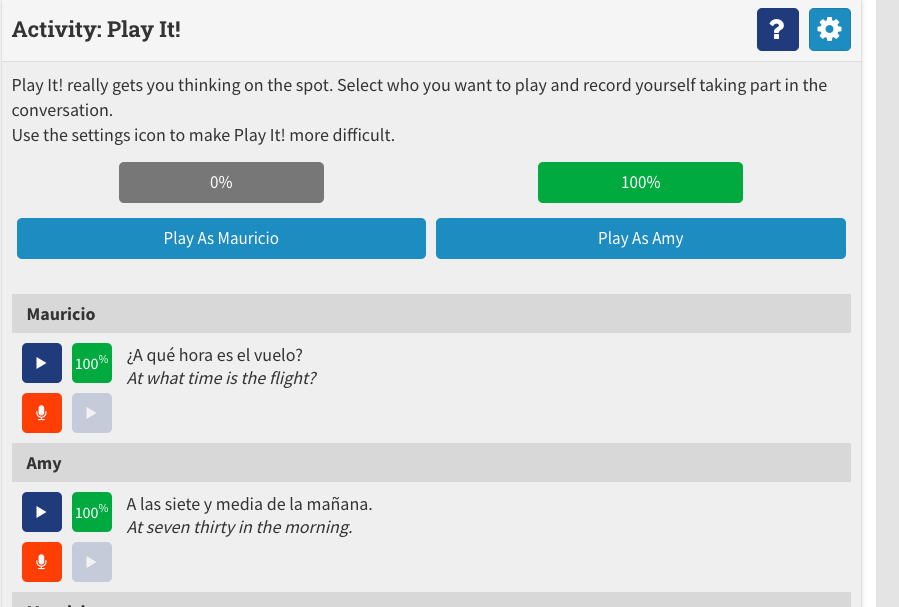
So once we’ve listened to the conversation and gone through the entire audio lesson, then we get to choose to play as Mauricio or Amy. The system records our voice as we take part in the conversation. In the video at timestamp 6:51 I demo this for you so take a look at the video.
Afterwards, we get to play back our conversation. The voice recognition system gives you a rating on each phrase as to how well you pronounced it.
I really love this role-playing feature because it puts you completely into the conversation. You can switch roles between Mauricio and Amy which helps you work on the masculine and feminine adjectives.
Other Reinforcement Activities
In addition, there is a section for extra vocabulary that is related to the lesson. These are related words and phrases that we may not have really learned within the audio lesson in detail. We can listen to these words and phrases.
In the extra audio section, we can listen to the entire Spanish conversation straight without any narrator interruption.
Rocket Spanish also has flashcards which use a spaced repetition system (SRS) style. The flashcards are always related to the lesson at hand. You have a lot of control here. You can choose if you want the front or back of the car to be English or Spanish. You can have sound on or off.
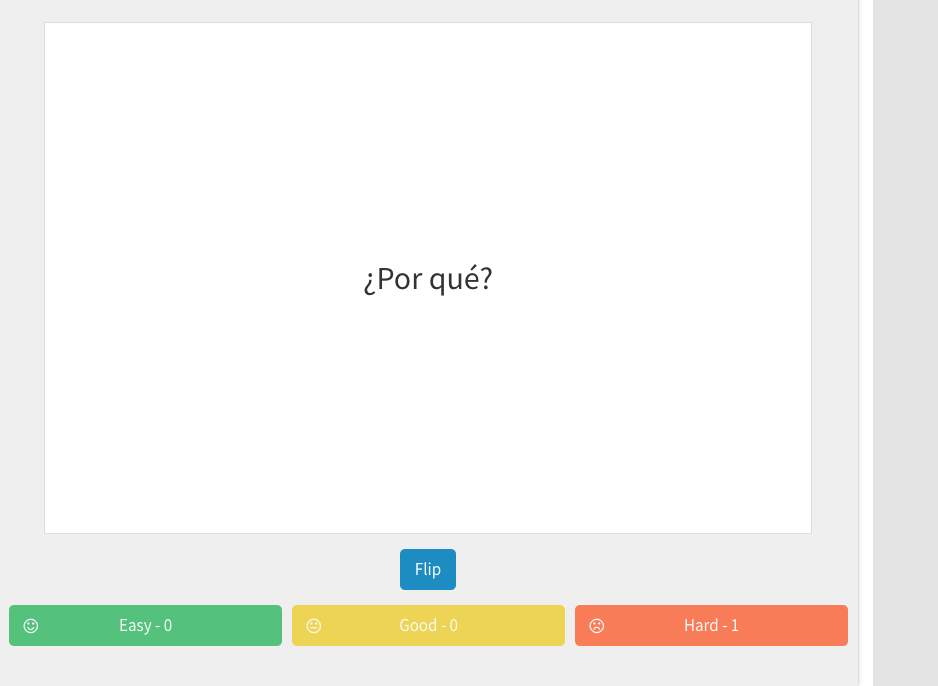
Once you flip the card around, you can choose how hard the word or phrase was for you by selecting a number. The flashcards will be put into either category easy, medium, or hard. In this way, you’re only focusing on what you most need. The system will not continue flashing cards that are easy for you. It’s very personalized.
There is another section called, “Hear It, Say It.” This section also has related vocabulary, but it works in the same way as the flashcards do. You will actually record your voice saying the words and then rate them easy to hard. The words or phrases are then categorized just like the flashcards for personalized practice.
There is also a section for writing and the system will rate your spelling. There is a built-in area for special characters as well so you don’t have to struggle with that from your own keyboard if you don’t know how. The writing, just like everything else, gets more extensive as we move on to other levels.
The next activity called “Know It’, shows you a phrase in English and then you need to say it in Spanish. Again, the system will rate your pronunciation and you will rate the phrase easy to hard.
Finally, we have a multiple-choice quiz at the end.
How Good is the Voice Recognition System?
The voice recognition system gives you a score from 0 – 100 according to how well you (supposedly) pronounced the word or phrase. Take this with a grain of salt. It is a computer software after all. You do have the option to choose if you want the software to be easy, medium or hard. That has to do with how hard you want it to rate you.
I’ve kind of played around with all of the settings and I don’t see a huge difference. I mean, I’ve tried to really butcher the pronunciation. You can see me do this in the video at timestamp 12:15 and you’ll see that it still gave me 100%.
So don’t depend on the voice recognition rating system. Fortunately, within the audio lesson, there is so much opportunity to really practice your pronunciation by listening to Mauricio and repeating. He repeats one part of the phrase at a time, and then he eventually completes the entire phrase, and you’re practicing part by part. So that is really where you need to focus on your pronunciation.
Additional Features of Rocket Spanish
You’ll find a progress tracker, so it gives you a certain amount of points for the day according to how many activities you have completed. So that can be motivational. We even have a leaderboard, which helps you know your ranking amongst all of the Rocket Spanish users. You can see your streak, which is how many days straight have you been on the platform.
In the “My Tools,” section, you can access a forum so you can chat with other users or even tutors. You can add notes at the bottom of each lesson.
You can even make your own flashcards. You can easily create your custom set of flashcards either manually or by uploading a list. So that’s super cool. If you’re walking around during the day and making a vocabulary list of things that you find throughout your day, you can literally come here at the end of the day and put those in flashcard form.
The full audio lesson and PDF of the conversation are downloadable as well as mobile-friendly, so you do not have to be connected to the internet to listen to your audio lesson.
Language and Culture (Grammar) Lessons
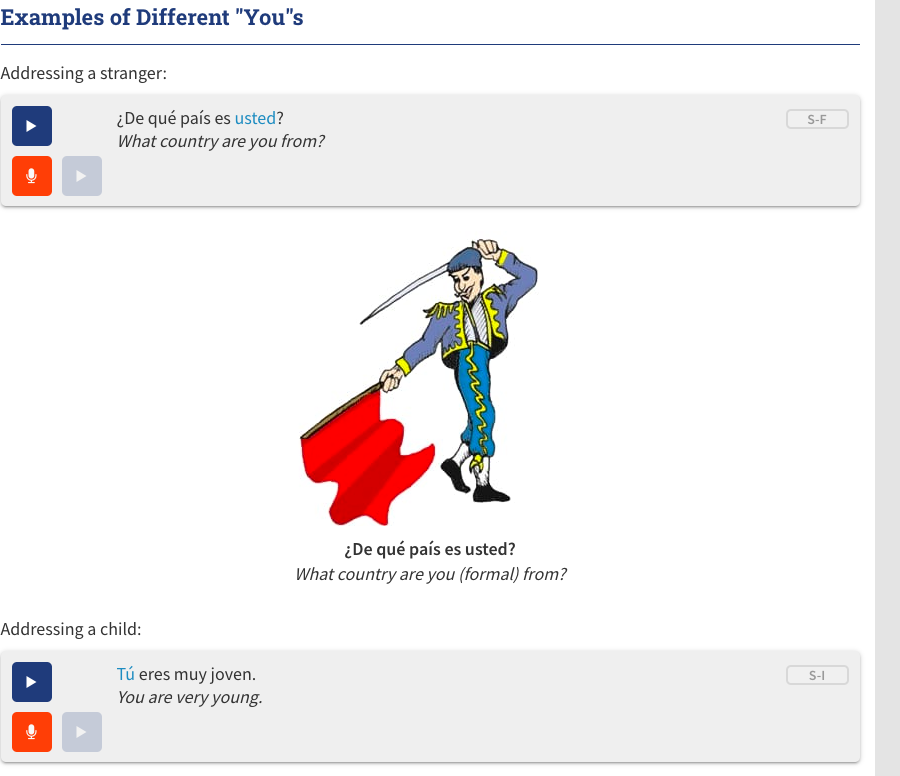
In addition to the interactive audio lessons, we also have language and culture lessons. These are basically grammar lessons, although they’re not stating that outright. But most of them have to do with some type of grammar point. Some examples are, “People, places and things”, “using articles,” “you, he and we, and other pronouns,” and “to be, the verb ser.”
Just like any other area of Rocket Spanish, we’re going to be able to both hear the speaker and record ourselves throughout the entire lesson.
This section also has cultural notes. Within the interactive audio lessons we get a bit of this already, which is great. But in the Language and Culture Lessons, we expand on different regions of Latin America.
It’s set up in the same way as the interactive audio lessons with these same features for our additional practice – the hear it, say it, write it, know it, a quiz, and a section for notes. So it’s a really good extension to the audio lesson.
Survival Kit Lessons
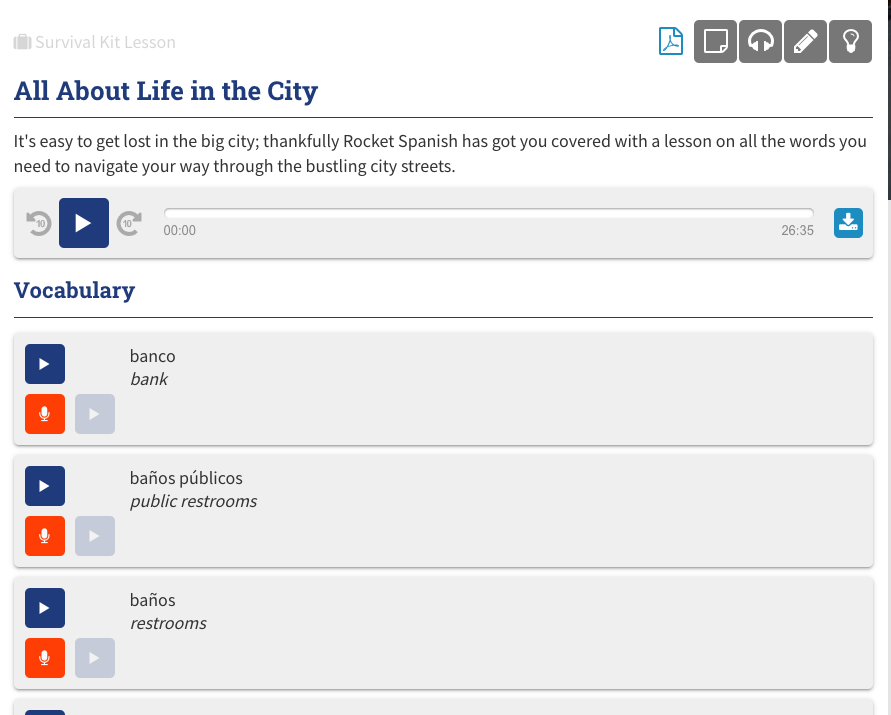
We also have our survival kit. The survival kit lessons give us additional vocabulary for very specific categories. For example, we have “describing your body parts”, “all about life in the city”, “shopping”, “clothing,” “Spanish and English cognates,” and “medical Spanish.” Again, you can listen to the words, record yourself saying the words, and play them back.
Travelogue
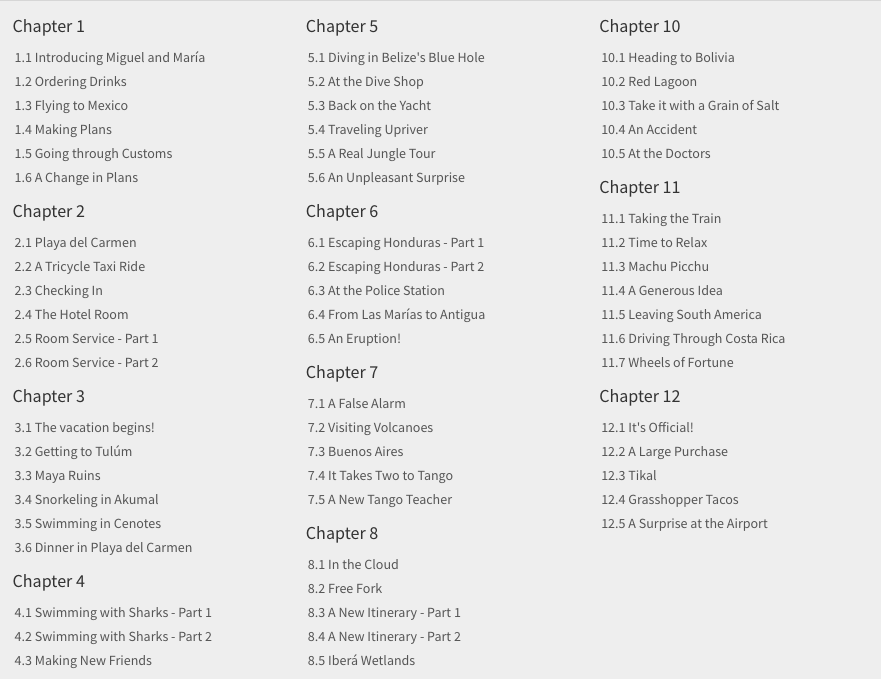
This is available as an extra feature for purchase. These are really nice, quite extensive extra chapters, all about travel specifically. So we have modules on ordering drinks, flying to Mexico, going through customs, Playa del Carmen, room service, the vacation begins, getting to Tulún, escaping Honduras, etc… So they are very, very travel specific. You could definitely go through the trial lessons and see if you like it and you can upgrade to this at any time.
Clips from Rocket Spanish Level 2
I want to let you see (or hear at timestamp 17:28 in the video) a sample of the other levels so that you get an idea of how far the system progresses.
[BEGIN AUDIO CLIP]
Mauricio: Cuando tú vas a las escuelas de mi país, siempre escuchas muchas de las historias de chile.
Amy: El español Cristóbal Colón descubrió el nuevo mundo en el año 1492.
Mauricio: Cristóbal Colón creía que era la India, y por eso llamó a los indígenas sudamericanos, “Indios”.
Speaker: When Mauricio went to school in his country, he learned that Cristopher Columbus discovered America. I hope you noticed the difference in verb tense in that last sentence. In Spanish, just like an English, you can have more than one verb tense in a sentence. For example, “when I studied at school, I discovered that I liked history”.
Amy: Cuando yo estudiaba en la escuela, descubrí que me gustó la historia.
[END OF AUDIO CLIP]
So, of course, they’re there about to jump into the perfect and the imperfect past tenses of Spanish verbs. But they do it in a fun way,. You’re learning everything in context.
Clips from Rocket Spanish Level 3
Let’s hop over to Level 3 so that you can read/hear a little clip of that one as well at timestamp 18:36.
[BEGIN AUDIO CLIP]
Amy: Interviewer Mauricio, the floor is yours.
Mauricio: Buenas tardes, toma asiento.
Alejandra: Gracias.
Mauricio: Dime, ¿qué experiencia tienes de secretaria?
Alejandra: Recibí mi diploma hace cuatro años. Desde entonces, he trabajado en proyectos de corto y mediano plazo como asistente y coordinación de personal.
Mauricio: ¿Qué tipo de proyectos?
Alejandra: Producción de programas para televisión, Desarrollo de eventos corporativos, y recepción de clientes.
Mauricio: Este trabajo requiere un mínimo de seis, a tiempo complete. ¿Tienes algún problema con eso?
Alejandra: No, para nada.
Mauricio: ¿Tienes transporte propio? Puede que tengas que ir a eventos fuera de la ciudad, y juntarte con clientes en eventos de noche.
Alejandra: Sí.
Mauricio: ¿Tienes alguna minifalda?
Alejandra: Mauricio, no creo que tener minifalda sea un requisito para este trabajo.
Mauricio: Puede que el jefe te pregunte, uno nunca sabe.
Alejandra: Ya, ponte serio.
Speaker: [19:38] Alejandra will be a full time employee for six months if she gets this job. Do you have any problem with that Alejandra?
Mauricio: ¿Tienes algún problema con eso?
Alejandra: No, para nada.
Amy: That’s a great question, by the way. Do you have any problem with that? It’s perfect for a number of situations that I’ll leave to your imagination, and “Para nada” is a great response. “Not at all. Para nada.” So she can do the six months. What else do you need to know, Mauricio?
[END OF AUDIO CLIP]
So we can see how that conversation got a lot more complex. There’s a lot of subjunctive being used within that, and the host breaks things down in the same way. So it’s not a word by word translation, which is nice. She kind of just comes into the conversation, picks out those key points, tells us what is being said, picks out those key phrases that we can take and transfer to other situations.
Summary of What I Love About Rocket Spanish
In summary, what I really love about Rocket Spanish is that it’s a conversation-based course. Listening to actual conversations in a language is one of the best ways to learn it. I also enjoy that grammar points are not explained and explained to death. They are really more demonstrated with examples, which is so much easier to learn in a more natural way.
The speakers are lively, so it’s not boring. The situations that they get into are really interesting. I’m having a lot of fun with it and I already speak Spanish, so I know that you guys are going to like it. Situations are pretty much everyday real situation, so you’re kind of learning the most important things that you’re going to need first before you learn about other more obscure topics.
I also love that they include culture in there so that we get to see some cultural points of Latin America. I love that everything is downloadable, everything is mobile-friendly, and the Spanish is not overly formal. You have some street Spanish in there. It’s Spanish how it’s actually spoken.
What I Dislike About Rocket Spanish
Nothing is perfect so there are things that can be improved upon. I already mentioned the voice recognition system. I just don’t feel like it was even necessary. I see how it could be kind of fun and motivational and you’re trying to get 100%, but you saw how I butchered a phrase and it still gave me 100%. So definitely do not rely on that as I’ve already said.
As for our host, Amy, I appreciate her as a narrator and her personality. When she’s explaining things to us in English, it’s great. But I don’t know why she is one of the main speakers within the conversation. When I’m going to learn a language I want to listen to native or near-native sounding speakers more than anyone else because I’m trying to develop good pronunciation habits. However, her pronunciation is acceptable and this is not a deal-breaker. As you could see in the demo, when we’re really working on our pronunciation, we’re doing that with Mauricio, who is a native speaker.
Testimonials
What are people saying about Rocket Spanish?
Here are a couple of examples out of thousands that you can review on the website.
Jeremy Prendergast
Naperville, United States
I have been using Rocket Spanish for 4 months now and amazed at how much I am learning. I listen to the 20-30 minute lessons while on a walk and spend another 15-20 minutes working towards my daily points goal.
Rocket Spanish is fun and effective. And I get to learn at my own pace.
______________________
Beverly Favors-Jones
Clinton Township, MI, United States
I LOVE this course! It’s hands-down one of the best ways to learn a new language. After learning new words in one lesson, the following lessons reinforce what has already been learned by allowing us to listen to a real conversation. So, we are not only memorizing words, we’re getting a chance to hear the words spoken. We can listen to conversations over and over until we fully understand what is being said
How Much Does Rocket Spanish Cost?
Here is a screenshot of the current pricing of Rocket Spanish.

As you can see, with the current automatically applied discount code you can get ALL 3 levels of Rocket Spanish for $259.90, a 40% discount from the regular price of $449.85.
$259.90 buys you 370 hours of lesson time, 10004 phrases with voice recognition, 98 interactive audio lessons, 87 language and culture lessons, and 3 bonus survival kits with tons of extra vocabulary.
This is honestly an amazing deal. I myself have invested in Rocket French to help me learn my third language!
TRY ROCKET SPANISH FOR FREE AND GET MY BONUS
If you are still on the fence, you’ll be happy to know that Rocket Spanish has a 7-day free trial where you can try it risk-free. You do not have to put in a credit card. There’s no chance of you forgetting to cancel your trial.
If you do use my affiliate link to make your purchase within your 7-day trial period, I’m going to include a special bonus for you. I’ll be giving you my exclusive 6000+ word eBook all about vocabulary acquisition and retention in Spanish.
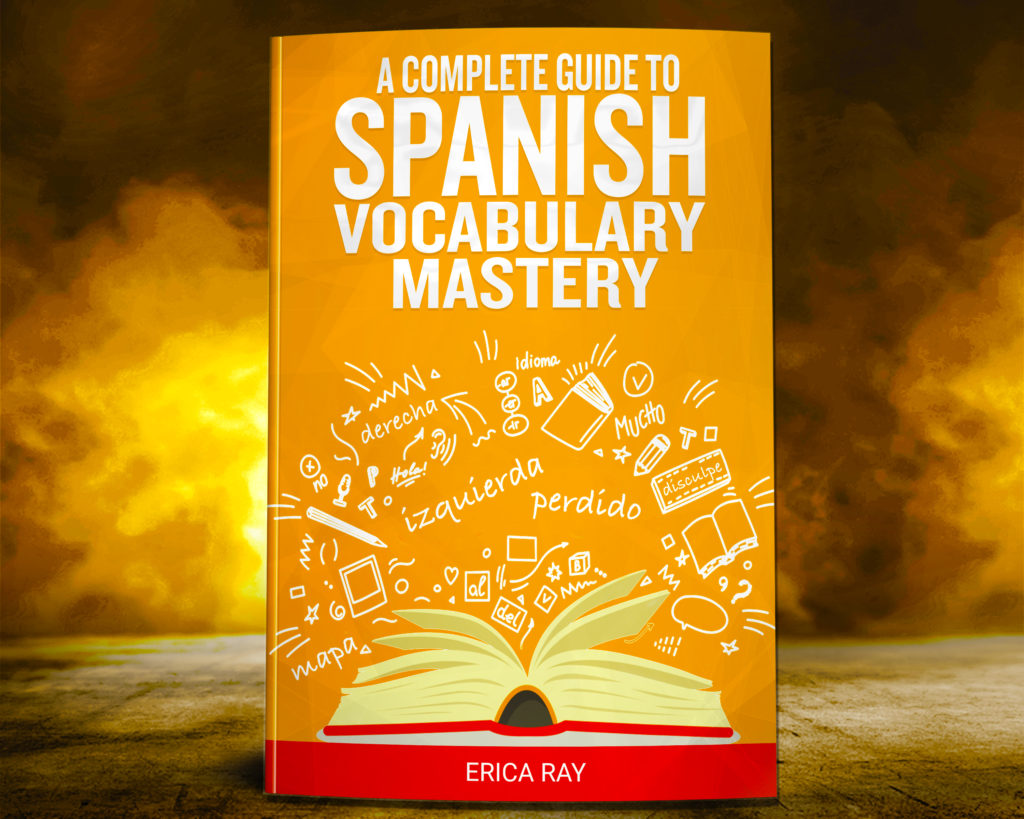
Now this book is not full of fluff. I do want you to understand why these vocabulary retention methods work, but what I mainly want for you is for you to walk away feeling motivated and prepared with actionable tools to take some of the fear away from learning large amounts of vocabulary. Rocket Spanish provides you with lots of new vocabulary. The more and the faster you can learn new vocabulary words and phrases, the faster you will gain confidence in Spanish and become conversational.
In the beginning, it’s all about those quick wins. When you can understand and be understood, you’re motivated to keep pushing, keep learning, and achieve greater and greater levels of fluency. And that’s why I’m so happy to give you this tool completely free with any purchase of Rocket Spanish. Purchase through the link here and then contact me at erica@ericaraylanguage.com with a screenshot of your receipt or proof of purchase and I will happily get that bonus right over to you.
Guys, have you used Rocket Spanish? What is your opinion? Let me know your thoughts in the comments below.
Like this? PIN IT and follow me on Pinterest. 🙂
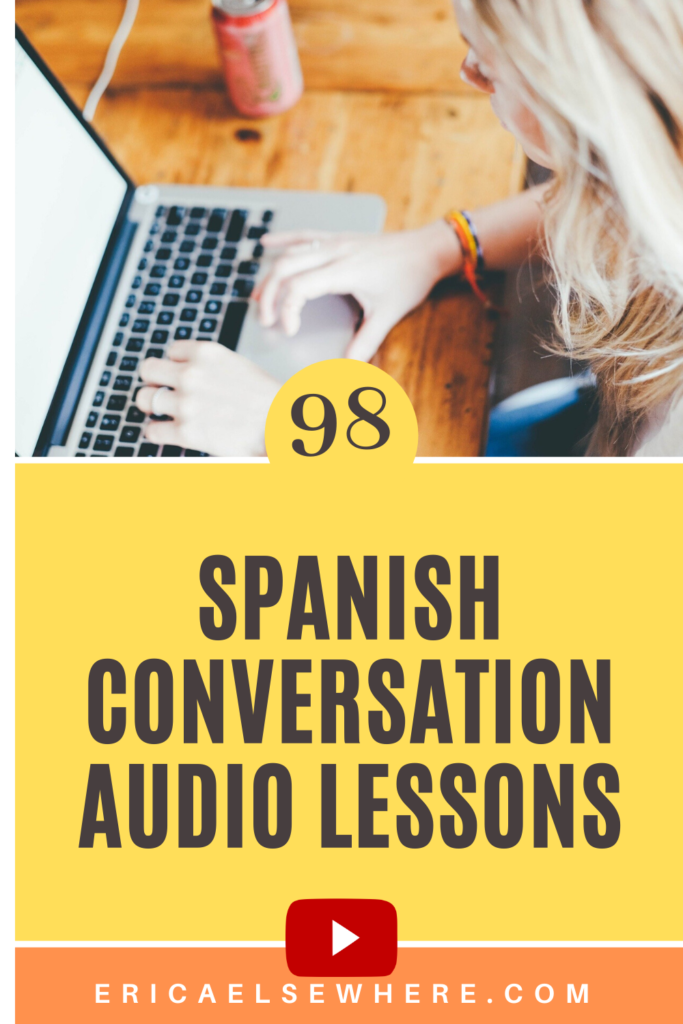
You may also be interested in reading Why Adults Can Learn Languages Faster Than Children!
Erica Ray
Latest posts by Erica Ray (see all)
- How to Say Goodbye in Spanish 26 Different Ways! - February 18, 2020
- Spanish Conversation for Beginners (VIDEO) Lesson #2 – Greetings and Walking Directions - February 9, 2020
- Bilingual Spanish/English Short Story Video: Las Flores de Mi Jardín - January 25, 2020

